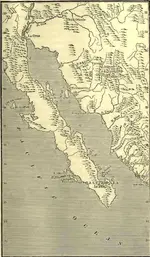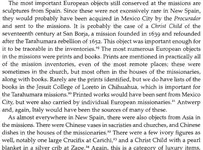In a letter to the governor of Sonora written the same day, Garcés more fully described the situation he perceived at his mission and its branch. Those portions of this missive dealing with Bac and Tucson bear translation here. They add to the evidence as to how rapidly Garcés learned facts pertinent to his ministry, such as the presence of San Pedro River Sobaipuris in Tucson and the extent of Jesuit christening of Papagos not living in the mission or its branch pueblo:
… These missions of San Xavier and of the Tugson are quiet. The Indians are content to see that our King wants them as people and not as slaves. As regards doctrine: in the Tugson, none. They have not prayed nor have they a fiscal. In San Xavier, a little less than none, because they do not know it either in Spanish or in their own language.
[page 28]
They have never known it in their own tongue. This is not the worst, because here it has never been possible to assemble the married adults, not even on most occasions our own partisans. Consequently, with great diligence I succeeded in gathering the young people, but few married persons among them. I did not employ violent means to overcome their resistance because things are as they are, and so that I might test other methods. Everyone goes to live in the maizefields and plantings, which they greatly love. This pleases me because thus they eat and halfway clothe themselves. I trust in God that He shall succeed in teaching them the Doctrine with the measures that may be taken. In the beginning neither children nor adults came until I personally went twice to their ranchos, by which means I explained things to them and persuaded most of them to come. The Governor and the justices tell them to come and will make them come, because it is convenient thus. By force or by free choice they must come. Yet I am not inclined to be rigorous. I only threaten the children, and I have begun to spank them so that they should not play hookey. In order to do so, I quieted the scruples of the Governor, who put himself up to telling me that he had read a letter that said that one could not strike Indians. In a word, I am not discontented. The young people do well. If Your Lordship should approve, the adults will be treated a little more forcefully.
The people of the Tugson are content. They told me that they wished no other priest than me — but only when they were well informed that the priest would not make them work as had the Jesuits, that the King greatly cares for them, and that they would not be less than the others. They are a bit flexible. Having closed the old site of the pueblo because of the Apaches, they have made me a little hut at my request. They have given me a youth to instruct. I have told them that in August I am going to spend eight or fifteen days with them and that I shall alternate [between Bac and Tucson]. They do not seem to me to put on a bad face [at that].
The governor and residents of Santa Cruz who are in the Tugson say that they are content, that they live well, plant and remain here happily. This they told me after asking me if [the authorities] wished to remove them from the Tugson. I have assured them that the King wants them to live well and to have a priest, but that he will not treat them violently so that they would go elsewhere.
There are people, but not as many as it seems. The Papaguería makes the population bulk large. Now that the Papagos have gone to their lands, however, one sees that there are not so many. Those whom I have recognized at San Xavier do not number sixty families to date, but there could be more. In the Tugson, there are that many more huts for the inhabitants, which is better to my way of thinking, outside of two rancherías. As they say, there is no doubt that there is a baptized multitude from West of this Mission to the North of it, inasmuch as they are mentioned and evidenced by the registers. The 1,108 baptized yields a great discrepancy from the 213 deaths, 246 marriages, and 500 confirmations, all these since the year 1755.
Some of the country people have given me hopes that they will join the Mission. I have promised that if they are sick and call me to hear their confessions, I will go. I promised that I will go to see their ranchos that they say are lacking in water.







 [/FONT]
[/FONT]

 The modern historians almost never mention those mines owned openly by the Jesuits or if mentioned at all, it is a passing notice. Not to mention the rich ornaments recorded BY Jesuits as being in ALL of their missions, including the remote and small ones, which were not to be seen when the Franciscans took over - what happened to that stuff?
The modern historians almost never mention those mines owned openly by the Jesuits or if mentioned at all, it is a passing notice. Not to mention the rich ornaments recorded BY Jesuits as being in ALL of their missions, including the remote and small ones, which were not to be seen when the Franciscans took over - what happened to that stuff? 